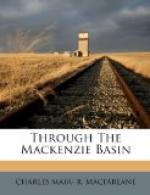But to the harness. This is simply an adjustment of leather breast-straps for each man, tied to a very long tracking line, which, in turn, is tied to the bow of the boat. The trackers, once in it, walk off smartly along the bank, the men on board keeping the boats clear of it, and, on a fair path, with good water, make very good time. Indeed, the pull seems to give an impetus to the trackers as well as to the boat, so that a loose man has to lope to keep up with them. But on bad paths and bad water the speed is sadly pulled down, and, if rapids occur, sinks to the zero of a few miles a day. The “spells” vary according to these circumstances, but half an hour is the ordinary pull between “pipes,” and there being no shifts in our case, the stoppages for rest and tobacco were frequent. At this rate we calculated that it would take eight or ten days to reach the mouth of Lesser Slave River. Mr. d’Eschambault and myself, having experienced the crowded state of the first and second boats, and foregathered during the trip, decided to take up our quarters on the scow, which had no awning, but which offered some elbow room and a tolerably cozy nook amongst the cases, bales and baggage with which it was encumbered.
We had a study on board, as well, in our steersman, Pierre Cyr, which partly attracted me—a bronzed man, with long, thin, yet fine weather-beaten features, frosty moustache and keenly-gazing, dry, gray eyes—a tall, slim and sinewy man, over seventy years of age, yet agile and firm of step as a man of thirty. Add the semi-silent, inward laugh which Cooper ascribes to his Leather-Stocking, and you have Pierre Cyr, who might have stood for that immortal’s portrait. That he had a history I felt sure when I first saw him seated amongst his boatmen at the Landing, and, on seeking his acquaintance, was not surprised to learn that he had accompanied Sir John Richardson on his last journey in Prince Rupert’s Land, and Dr. Rae on his eventful expedition to Repulse Bay, in 1853, in search of Franklin. He looked as if he could do it again—a vigorous, alert man, ready and able to track or pole with the best—a survivor, in fact, of the old race of Red River voyageurs, whose record is one of the romances of history.




